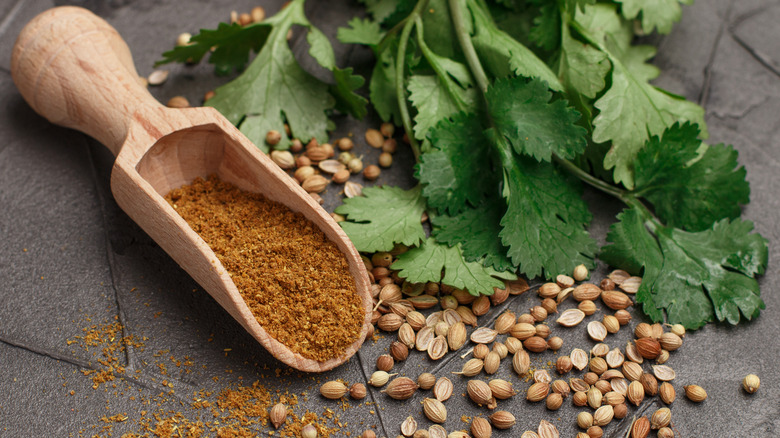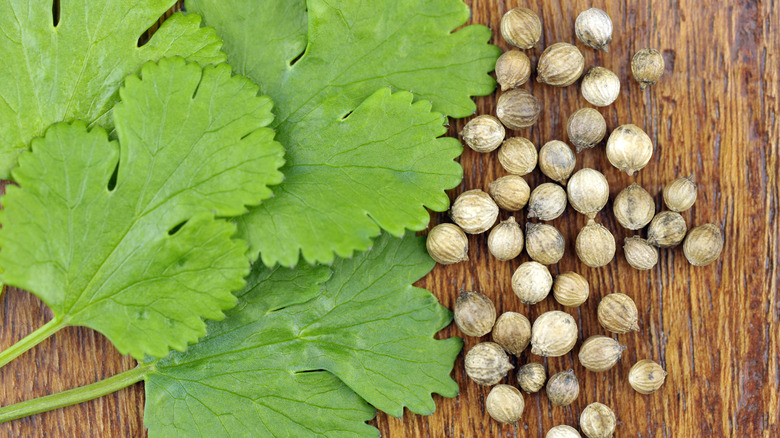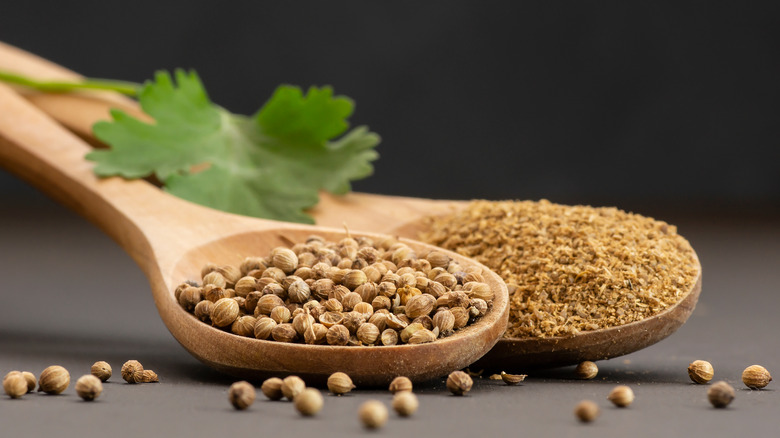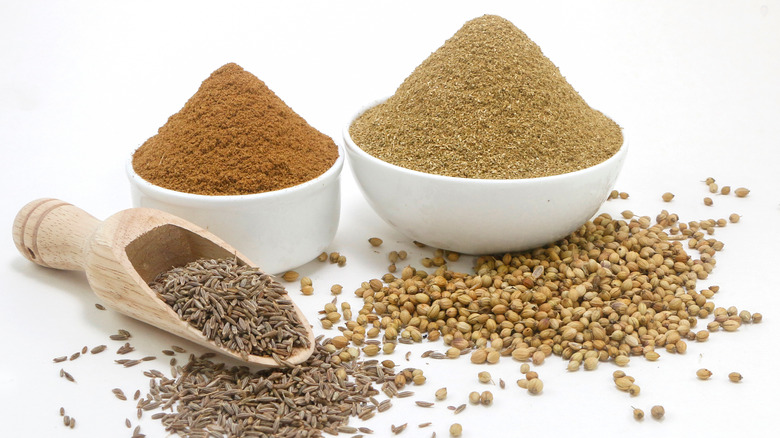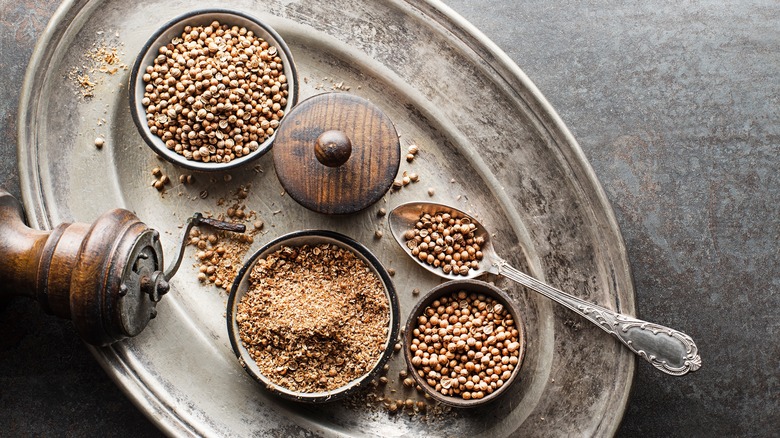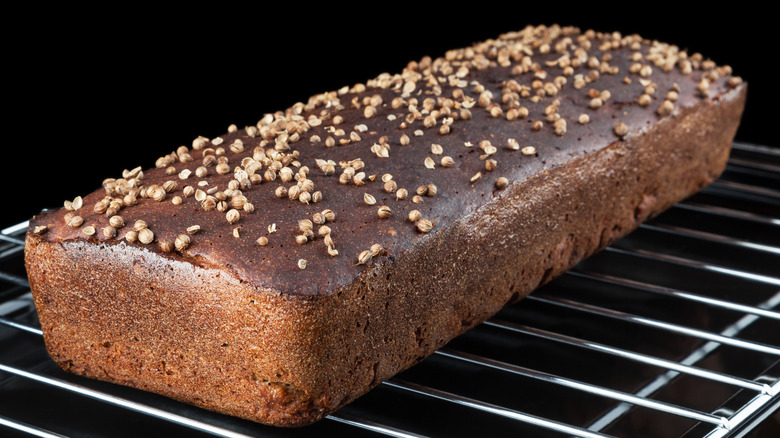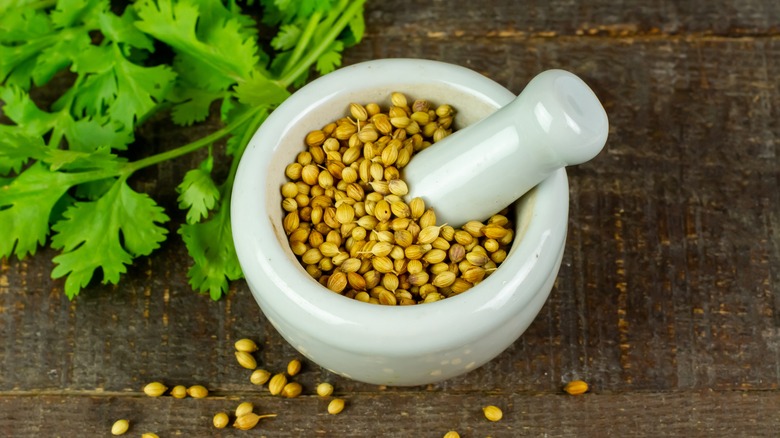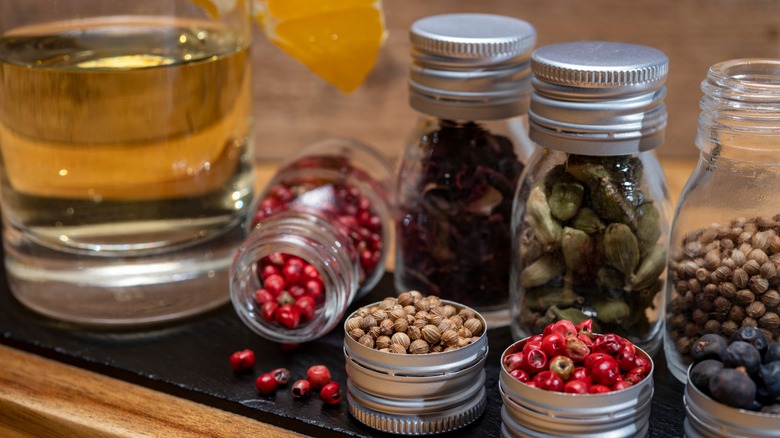What Is Coriander, And What Does It Have To Do With Cilantro?
Before any discussion about coriander can take place, we first must define what it is, and what it's got to do with cilantro. That's because their names mean different things in various places, and it can get confusing. They both come from the same plant (Coriandrum sativum), with its leaves used as an herb, and its seeds used as a spice. In the United States and Latin America, the Spanish name cilantro is used for the leaves, and the seeds are called coriander. Meanwhile, in the UK, Australia, and many other parts of the world, the name coriander refers to all parts of the plant, differentiated as coriander leaves, or coriander seeds.
Coriander plants grow to three feet tall and produce flat, aromatic leaves that are easily mistaken for parsley, which is in the same Apiaceae family, along with carrots, celery, and fennel. The similarity of the cilantro leaf to its cousin gives the coriander plant its nickname, Chinese parsley. Its small, white flowers bear tiny fruit that mature into dry, seed-filled husks. These are harvested for the spice coriander.
As one of the earliest documented spices, coriander is believed to be native to the Mediterranean but is now grown worldwide. With its roots deep in history, records of coriander date back to 5000 B.C. Its seeds were found inside the tomb of the Egyptian pharaoh Tutankhamun (circa 1341—1323 B.C.), and coriander is even mentioned in the Bible, which likens it to manna from heaven.
Coriander vs Cilantro
Cilantro's green leaves are used as a fresh or dried herb. Its flavor is a bold, slightly pungent mix of lemony and peppery, perfect for cooking aromatic foods — just like ginger. Used raw as a garnish, cilantro is the finishing touch on Vietnamese banh mi sandwiches, pad Thai noodles, Mexican tacos, and Indian curries, or chopped and mixed into guacamole. Despite its global popularity, there is a segment of the population who have an aversion to cilantro. For some, cilantro tastes overwhelmingly like perfumy soap. A study by the DNA testing company 23AndMe found that many of those who initially dislike cilantro share the OR6A2 gene in common. The gene makes them sensitive to a chemical in cilantro that triggers the soapy smell. Famous chefs Julia Child and Ina Garten have both gone on record with their strong dislike of the herb. Still, it is possible to overcome this initial aversion.
Coriander seeds on the other hand are milder, with a less aggressive presence. The spice gives a mellow, citrusy nuttiness to whatever it is cooked with. Along with their different names and flavors, coriander and cilantro's uses differ as well. While they come from the same plant, they are not interchangeable.
You will find coriander in the spice aisle, and cilantro in the produce department at most grocery stores. A pro tip for following recipes is to always double-check which is the right version of coriander called for in the ingredients. American cookbooks will say cilantro when they mean the leaves while British cookbooks will call it coriander.
What is coriander?
Coriander is an aromatic spice made from small fruit seed pods. The tiny fruit is three to five mm in diameter, and each one holds two seeds inside. The seeds start out tan and turn brown or green once dried. Both the whole pods and the ground seeds can be used and are a subtle but key ingredient in everything from grilled meats, German sausages, and African stews, to baked breads, desserts, sweets, and beverages.
Coriander is a favorite spice considered essential in many international cuisines. It is used extensively throughout Asia, Southeast Asia, India, the Middle East, Europe, Latin America, and Africa.
In India, the Hindi name for coriander powder is dhaniya. Whole, roasted, and seasoned coriander seeds are also enjoyed as a snack called dhana dal, which doubles as a breath freshener and digestive aid. Ground coriander seed is known by the name ketoembar in Dutch and Indonesian cooking, and in Japan, the entire coriander plant is called pakuchi, which is a transliteration of pak chee, as it is known in Thailand.
What does coriander taste like?
Coriander is a mild and versatile spice that enhances rather than masks whatever it is cooked with. Its flavor can be likened to a blend of cumin with sage, lemon peel, anise, or caraway. Coriander's taste is commonly described as warm, spicy, nutty, citrusy, earthy, mellow, aromatic, and a touch sweet.
Coriander is most often paired with cumin, which has a smokey and slightly bitter profile that goes well with the milder spice. Other spices that are frequently matched with coriander are cinnamon, paprika, nutmeg, pepper, allspice, turmeric, chili, and ginger. In a pinch, coriander can also stand in for most of those as a substitute.
Some of world cuisine's most beloved spice blends and condiments are also made with coriander. In India, the blend of coriander with cumin is called dhana jeera. Coriander is also a main ingredient in most curry blends and garam masala. The red chile pepper paste harissa, which is eaten throughout the Middle East and North Africa, is made with coriander. Toasted coriander is an ingredient in the Arabic baharat spice blend. The Egyptians include coriander in their crunchy nut, seed, and spice blend called dukkah. Ethiopia also has its own spicy berbere mix that matches coriander with sweet paprika and hot chiles.
How to cook with coriander
Coriander seeds can be used whole in their pure state, or they can be toasted and then kept whole, or ground into a powder. A rule of thumb is that 1 ¼ teaspoons of coriander powder equals 1 teaspoon of whole seeds.
Toasting coriander seeds brings out their natural oils and punches up their floral aroma and nutty flavor. To toast, heat a skillet to medium and dry roast the seeds for two or three minutes until they become fragrant, start to darken, or pop. Do not let them burn, or their taste will turn bitter. Use whole or allow to cool completely before grinding, which can be done by hand using a mortar and pestle or in a spice grinder. You can also put the seeds into a pepper grinder for a coarser grind, and coriander is in fact a nice substitute for black peppercorns.
Determine if the dish you are making would work best with whole or if ground coriander is better. Ground coriander works well in curries, stews, soups, and chilis, while the whole seeds go great in meat rubs, chutneys, and brines. Whole seeds should be used at the start of cooking so that they will have time to soften and develop their flavor, as in slow-cooking sauces or roasts.
What to cook with coriander
Coriander is excellent for cooking savory foods like dry rubs for meats and fish, stews, soups, curries, roasted vegetables, as well as in pickling brines. Coriander also adds a zing of bright notes to baked goods and sweets. The ground powder can be added to dough, and whole seeds can be used instead of caraway in Russian Borodinsky rye bread. It folds beautifully into cookie dough, spiced cake batter, sauces, syrups, and fruit compotes.
For a dash of inspiration, check out some of these coriander-forward recipe ideas. To find out how flavorful coriander can be in curries and Indian foods, Swiss chard coconut curry is a good place to start. Made with coriander seeds as well as cilantro leaves, it's a delicious recipe that flaunts the best of both. Spiced coconut lentil soup is another tasty choice that also uses both leaf and seed. Spicy saag gosht made with spinach and lamb kicks things up a notch with green chiles, fresh ginger, and whole coriander seeds.
Turning to the Middle East, lots of greens shakshuka brings together eggs with the power combo of coriander and cumin in a fresh take on breakfast or brunch. For a twist on a traditional classic, coriander, fennel, and mint-marinated lamb goes down smooth with a glass of wine. In chef Naomi Pomeroy's coriander seared tuna, coriander is at the forefront with the seeds pressed right into the fish's crust. Coriander-spiced chai tea adds a sweet finish to any meal.
Nutritional information about coriander
Although both are from the same plant, coriander and cilantro have quite different nutrient profiles, as dissimilar as their individual flavors. The main difference is that while coriander is high in minerals but low in vitamins, the opposite is true for cilantro, which — with its high-water content — contains a significant amount of vitamins but is low on minerals.
A 10-gram serving of cilantro contains 13.5% of the recommended daily intake (RDI) of vitamin A while the same amount of coriander has 0%. Cilantro also contains 38.8% of the RDI for vitamin K while coriander again has none. Both have moderate amounts of vitamin C, 4.5% for cilantro and 3.5% for coriander. Coriander does, however, come through with 9.5% manganese, 9.1% iron, 8.2% magnesium, and 7.1% calcium — all low in cilantro. Coriander also packs in 16.8% of the daily RDI of dietary fiber per serving (via Healthline).
More interesting facts about coriander
Coriander ranks just below juniper as a main ingredient in the production of gin. Chemically similar to juniper, the coriander seeds used in gin help enhance its citrus tones. Created in the 1830s, the famous, green-bottled Tanqueray London Dry gin features coriander in its blend of four botanicals, the other three being juniper, angelica, and licorice.
Coriander is also believed to have been used in the original secret formula for Coca-Cola (per This American Life). In a 2011 episode of the radio program This American Life, host Ira Glass revealed they had discovered an old newspaper column purported to have published Coke's first formula. Along with coriander oil, the other secret ingredients include orange oil, lemon oil, nutmeg oil, and cinnamon oil. Even though the Coca-Cola company subsequently denied the originality of the recipe, the producers of the show stand by their claims, based on the evidence that was found. As to whether coriander is still used in the current day recipe, as it has done for over a century, Coke remains staunchly hush-hush on the matter (via Chicago Public Radio).
The word coriander derives from the Greek koris or koriannon, which translates to stink bug, no doubt due to the pungent scent of the plant's leaves. Unsurprisingly, it turns out that the chemical compound called aldehyde that causes the soap-scented aversion some have to cilantro is the same chemical that gives stink bugs their funk. Furthermore, aldehydes also exist in soaps and detergents. Now it all begins to make sense!

